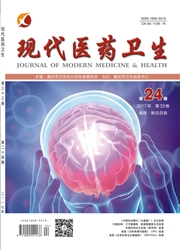

 中文摘要:
中文摘要:
目的探讨代谢综合征与无症状性颅内动脉狭窄的相关性。方法以中华医学会糖尿病学分会建议标准诊断代谢综合征,将2015年1~6月在该院以经颅多普勒超声诊断为大脑中动脉狭窄的患者526例作为病例组,无颅内动脉狭窄就诊的526例患者作为对照组,比较两组间人体测量学指标、生化指标及患病率的差异,根据代谢异常指标的数量(0-4)将所有研究对象分为M1、2、3、4、5组,分析异常指标数与颅内动脉狭窄患病率的关系,计算比值比(OR值)。结果病例组患者体质量指数、腰围、收缩压、舒张压、总胆固醇、三酰甘油、低密度脂蛋白胆固醇、空腹血糖,以及糖尿病、高血压和代谢综合征的患病率显著高于对照组,差异均有统计学意义(P〈0.01),而高密度脂蛋白胆固醇显著低于对照组,差异有统计学意义(P〈0.01)。随着M2、3、4、5组代谢综合征异常指标数从1个增加到4个,颅内动脉狭窄的检出率逐渐增高,与M1组比较,差异均有统计学意义(P〈0.01);并以M1组为基准,计算各组OR值,M2、3、4、5组相对M1组的OR值逐渐增大。结论代谢综合征是无症状性颅内动脉狭窄的重要危险因素,应控制好代谢综合征的每一项异常指标,以降低颅内动脉狭窄的风险。
 英文摘要:
英文摘要:
Objective To investigate the correlation between metabolic syndrome and asymptomatic intracranial arterial stenosis. Methods Metabolic syndrome was diagnosed according to the criteria recommended by the Chinese Diabetes Society of the Chinese Medical Association. Totally 526 patients with middle cerebral artery stenosis diagnosed by transcranial Doppler in our hospital from January to June 2015 were taken as the case group and other 526 subjects without intracranial arterial stenosis as the control group. The differences of anthropometric indices,biochemical indices and prevalence rate were compared between the two groups. All the research subjects were divided into the group M1,2,3,4,5 for analyzing the relationship between the abnormal in dexes number with the prevalence rate of intracranial arterial stenosis and calculating the odds ratio(OR). Results The body mass index,waist circumstance,systolic blood pressure,diastolic blood pressure,levels of total cholesterol,triglyceride,low density lipoprotein cholesterol and fasting blood glucose,and prevalence rate of diabetes,hypertension and metabolic syndrome in the case group were significantly higher than those in the control group,and the differences were statistically significant(P〈0.01),while the high density lipoprotein cholesterol level in the case group was significantly lower than that in the control group,and the difference was statistically significant(P〈0.01). With the number of abnormal indices in the group M2,3,4,5 increasing from 1 to 4,the detection rate of intracranial arterial stenosis was gradually increased,and the difference was statistically significant compared with the group M1(P〈0.01). In calculating the OR value in each group with the M1 group as the baseline,the OR value in the group M2,3,4,5 was gradually increased compared with that in the group M1. Conclusion Metabolic syndrome is an important risk factor of asymptomatic intracranial arterial stenosis. Each abnormal index of metabolic syndrome should be better co
 同期刊论文项目
同期刊论文项目
 同项目期刊论文
同项目期刊论文
 期刊信息
期刊信息
